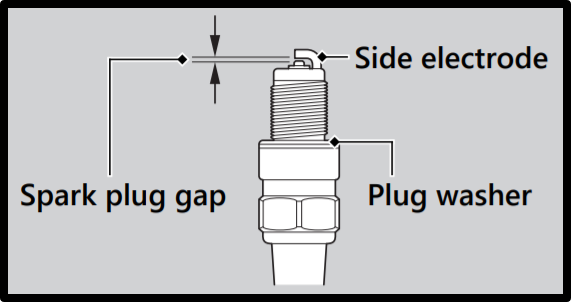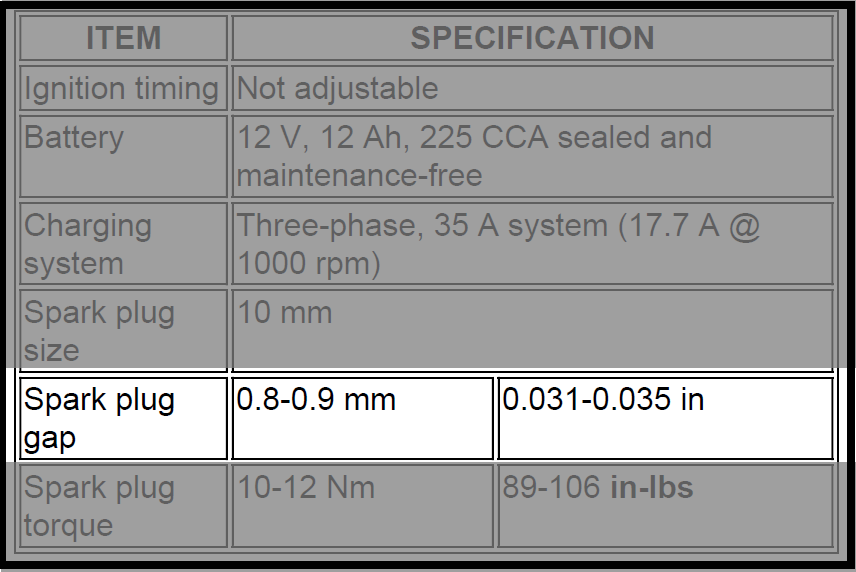The spark plug gap is the gap between the two spark plug electrodes. The gap needs to be in the desired range for smooth spark ignition.
But what happens if the spark plug gap is too small? If the spark plug gap is too small, the generated spark will be weaker and have less contact with the air-fuel mixture. This results in incomplete combustion of the fuel mixture or worse, no combustion at all leading to engine misfiring.
The same applies if the spark plug gap is too big as well. the gap should be in the recommended gap range. Neither too small a gap nor too big a gap.
Let’s deep dive into the recommended spark plug gap and why is it not desired to have the gap too small or too big.
Spark plug gap – what is it?
The spark plug gap is the space between the center electrode and the ground electrode in the spark plug. The ground electrode is also called the side electrode since it is, you know, on the side. :p

The central electrode produces the high voltage spark carried from the spark plug terminal through the central shaft. The ground (side) electrode, on the other hand, acts as the grounding for the high volt electricity generated by the center electrode. For more details, here is a post on spark plug parts and functions.
As for the spark plug gap, it is in this gap that the center electrode tip carrying the high voltage electricity generates the spark. This small gap between the center electrode and the ground electrode is where the spark ignition occurs.
The spark plug gap is critical because the distance between the two electrodes, center and ground, influences the electric arcing essential for fuel combustion. Without a proper spark plug gap, the arcing won’t be proper, thus affecting the ignition process in the engine combustion chamber.
Now, we discussed that the spark plug gap should be at the required optimum levels. If not, the fuel combustion in the engine can get affected. Let’s deep dive and take a look at what happens if the spark plug gap is too small.
What happens if the spark plug gap is too small?
If the spark plug gap is too small, the spark will be weaker and will have less contact with the air-fuel mixture resulting in incomplete combustion. Or even no ignition at all causing engine misfiring.
When the distance between the center electrode and the ground electrode is too low, i.e., a smaller gap, the spark produced will not have sufficient contact with the air-fuel mixture for proper ignition. And when there is too low a contact of the spark, the fuel mixture might not ignite properly and hence, not burn completely.
Another problem is the weak spark. Although the voltage drawn is less since the electric arc needs to travel a small distance, the spark produced will usually be weaker since it will be there for a very short time.
This weak spark combined with less contact with the air-fuel mixture can even result in no ignition at all. So don’t be surprised if the engine misfires because the spark plug gap is too small.
Is a smaller spark plug gap better?
A smaller spark plug gap is NOT at all better. There will be improper ignition leading to incomplete combustion of the fuel mixture in the engine. If the spark plug gap is too small, there might not be ignition at all. Thus, leading to engine misfiring.
So, a smaller spark plug is not at all desirable. If the gap is too small, you should increase it slightly and adjust it to the required spark plug gap range.
Now, we know too small a gap is not desirable, what if the spark plug gap is too big? Well, that is not desirable too. As for why, let’s dig in.
What if the spark plug gap is too big?
If the spark plug gap is too big, the spark requires more voltage to be transferred from the ignition coil resulting in higher electricity consumption and inefficient ignition.
If we have a big spark plug gap, then more spark comes in contact with the air-fuel mixture. The gap between the center and the ground electrode is high, so the electric arc will travel a longer distance. As a result, the spark has higher contact with the air-fuel mixture than usual.
However, the problem with this increased contact with the fuel mixture is the spark requires more voltage to be sent from the ignition coil in order to achieve the spark. This higher drawing of voltage is inefficient and simply not required since the air-fuel mixture will burn without just enough contact with the spark.
Does the gap on a spark plug matter?
Of course, the spark plug gap matters.
As discussed in previous sections, an optimal spark plug gap is essential for proper ignition in the engine. No matter the type of spark plug the engine is using, the spark plug gap should be as recommended.
That’s why even if the spark plug gap is preset, you need to double-check and adjust it for the right gap.
Too small a gap, the fuel mixture won’t burn completely. There might even be cases of engine misfiring with no fuel ignition.
Too big a gap, the spark plug draws too much voltage to create the spark. It’s an inefficient ignition since the electricity drawn from the ignition coil will be too much.
So, to avoid such inefficient ignition or engine misfiring, it is far more suitable to have the optimum spark plug gap in your vehicle engine. Neither too small a gap nor too big a gap is the best mantra.
What is the recommended spark plug gap?
For motorcycles, the typical spark plug gap is recommended between 0.8mm to 1.0mm (0.031 inches to 0.039 inches).
However, the best way to check the recommended spark plug gap is to look up the user manual for your motorcycle. Here is an example of the recommended spark plug range for a Harley Davidson model.

While different manufacturers might recommend different spark plug gaps, the usual recommendation for the gap is between 0.8 mm to 1.0 mm. On the imperial scale, the spark plug gap range will be bound between 0.03 inches to 0.04 inches.
